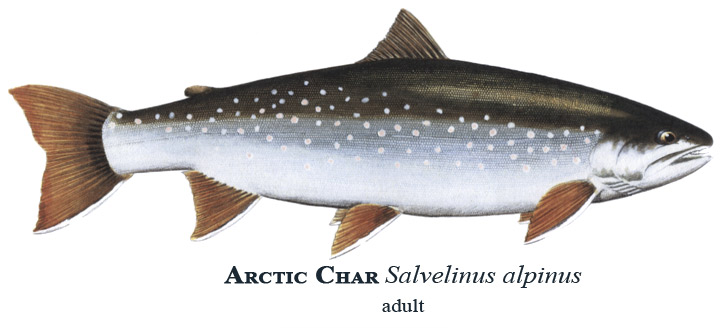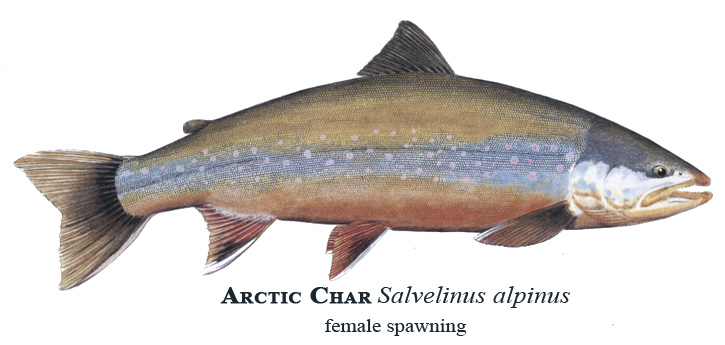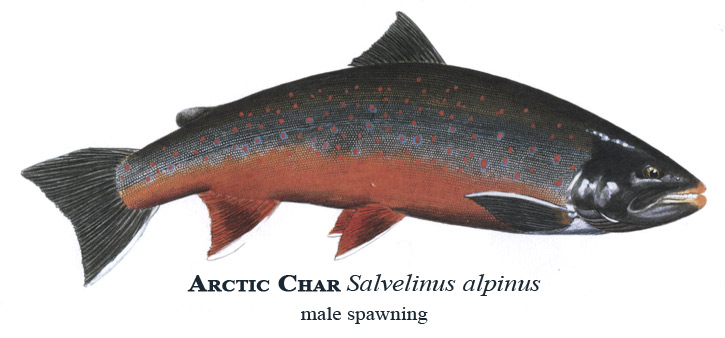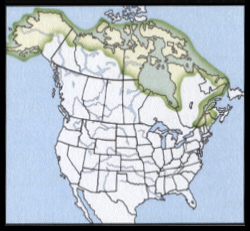Arctic Char, September 2012, Fish of the Month!


 Arctic Char
Arctic Char
Salvelinus alpinus
Local Names:
Alpine char, Lake char, Saltwater trout, Sea-trout
Average Size:
12 to 24 inches
0.5 to 7 lbs
Distinguishing Field Marks:
-
The mouth is large.
-
The upper jaw extends well beyond the rear edge of the eye.
-
The anal fin has 8 to 11 primary rays.
-
All chars have light spots on a darker background.

-
The caudal, anal, pelvic, and pectoral fins have white leading edges, as does the bottom edge of the caudal (tail).
-
The are no spots on the fins.
-
The anal, pelvic, and pectoral fins become brightly colored in spawning adults.
-
The caudal (tail) fin is moderately forked with a narrow peduncle.
North American Range:
Map to the right shows approximate range in North America.
Diet:
Until they are about 8 inches (20.25 cm.) long, Arctic char feed on aquatic insects and other invertebrates, especially shrimp. After that point in their growth, their diet changes to one almost exclusively of fish. Smelts, sticklebacks, sculpins, other Arctic char, and sand launce are most often consumed by adults.
Biology:
Arctic char spawn in the early fall in the northern reaches of their range and later in the south. The spawning period is from September through early December. Spawning takes place either in shallow lake water or in quiet pools of rivers. Spawning is not as showy as in other salmonid species. When the female has opened a nest site, she is joined by one male which usually attends her through her entire release of eggs, fertilizing them as they are deposited. Males may breed with more than one female.
In most of their range, female Arctic char spawn only every second or third year.
The fertilized eggs incubate in the gravel through the winter months and usually hatch around early April, but remain in the nest gravel until as late as early July.
Anadromous strains of Arctic char move out to sea when they are 6 to 8 inches (15 to 20 cm.) long and are from 5 to 7 years old. In the southern part of their range, char are larger at younger ages than those of the north. Sea-run Arctic char do not typically move far from the estuary of the river in which they were born.
Landlocked Arctic char may be spawned in tributary streams or in the lake itself. They grow more slowly and attain smaller sizes than their sea-run counterparts.
Fly Fishing for Arctic Char:
The range map for this species indicates the first order of business for anglers seeking Arctic char. For most, their far northern range will require extensive travel.
Sea-run fish are not generally not very large, perhaps 5 to 7 pounds (2.25 to 3.20 kg.) on average, so 6, 7, or 8 weight fly fishing outfits with floating or sink tip lines cover the necessary range. The choice of equipment is yours and will depend largely on your own preferences, the size of the waters you’ll be fishing, and the flies you’ll fish. An assortment of bright streamer fly patterns are the best bet for enticing Arctic char. For the best local fly patterns, consult a guide service in the region you plan to fish. The internet is also a good source for this type of information.
Because the cold climate in which they spend their lives makes these fish slow growing, anglers should be advised to treat them with respect, and release many more than they kill, in this way helping to secure their future.
It has been only relatively recently that sportsmen have begun to increase their pressure on this species. A few regional fisheries have suffered considerable loss of stock through angling over-exploitation. As always, those of us who fish have a responsibility to help maintain the species we prize.
Status:
Maintaining, but fragile because its place in the arctic web of life depends on all aspects of that delicate web remaining intact.






